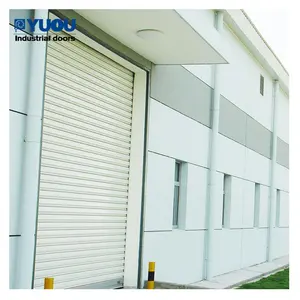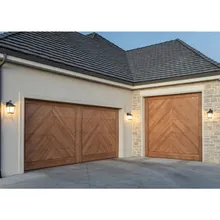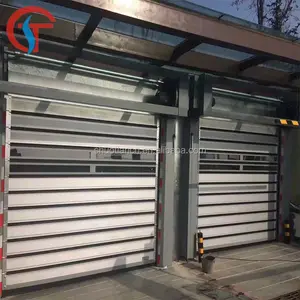Introduction
In the quest for energy efficiency and sustainability, insulated steel doors have emerged as a game-changer. These doors, constructed with robust materials like 18-gauge A40 Galv Steel face sheet and a polystyrene insulated core, offer a unique blend of strength, durability, and energy conservation. Primarily used in commercial applications, they are designed to withstand extreme weather conditions while reducing energy costs. This article delves into the world of insulated steel doors, exploring their construction, types, and the significant role they play in energy efficiency. It also highlights the additional benefits they offer, such as enhanced comfort, noise reduction, increased property value, and low maintenance.
Understanding Insulated Steel Doors
Insulated steel doors are constructed with an 18-gauge A40 Galv Steel face sheet and a polystyrene insulated core. These doors are designed for both interior and exterior applications, but are primarily used for exterior purposes. The door core is 3/4", which is the industry standard and the maximum allowed for a fire door. The door construction also includes a 10-gauge high frequency dual purpose hinge reinforcement for added strength and rigidity. These doors can be painted to complement any decor and are mainly used in commercial applications.
Components of Insulated Steel Doors
Insulated steel doors are constructed with several components that contribute to their robustness and functionality. The door face sheet (A) forms the exterior of the door. The core of the door (B) is filled with polystyrene insulation, providing thermal efficiency. The door also features a 10-gauge high-frequency dual-purpose hinge reinforcement (C) for added strength. The top (D) and bottom (F) channels of the door are 18-gauge inverted channels, welded to the door skins for rigidity. The door also includes an 18-gauge box-style door closer reinforcement (E). These components together make up the sturdy and energy-efficient insulated steel door.
Types of Insulated Steel Doors
Insulated steel doors, specifically hollow metal doors, come in various types based on their core material. The most common types include honeycomb, polystyrene, polyurethane, steel stiffened, and temperature rise cores. Honeycomb cores are heavy-duty and durable, often used in interior openings. Polystyrene cores are typically used in exterior openings, offering better insulation than honeycomb cores. Polyurethane cores provide the best insulation but cannot be fire-rated. Steel stiffened cores are ideal for high abuse areas or where sound transmission is a concern. Lastly, temperature rise cores contain a mineral board that reduces heat transfer, useful in fire situations.
Energy Efficiency and Insulated Steel Doors
Insulated steel doors, also known as energy efficient doors, are designed with a unique construction that significantly reduces energy costs. These doors consist of two steel pieces with a core material inside, preventing rapid temperature loss and lowering the U-value. This construction makes them ideal for regions with extreme weather conditions. Many professionals are now opting for these doors to meet regional codes and reduce energy costs. The thermal transmittance of these doors is generally tested to SDI-113 standards.
How Insulated Steel Doors Improve Energy Efficiency
One of the key benefits of insulated steel doors is their energy efficiency. These doors are typically thick and protective, making it difficult for conditioned air to escape from your home and for outside air to enter. The core of these doors is often made of foam insulation, and they usually come with weatherstripping that provides an airtight seal. This combination of features makes insulated steel doors one of the most energy-efficient options on the market.
Quantifying Energy Savings
Energy efficient steel doors, such as insulated steel doors, significantly lower the U-value, reducing energy costs in areas with hot or cold weather. Their unique construction, featuring a core material within two pieces of steel, prevents temperature loss from transferring outside quickly. This energy efficiency is particularly beneficial for building owners looking to meet regional codes and reduce energy cost requirements. Manufacturers typically test these doors to SDI-113 for the thermal transmittance of steel door and frame assemblies.
Additional Benefits of Insulated Steel Doors
Insulated steel doors offer several benefits beyond energy efficiency. They provide better control over warehouse conditions, enhancing comfort for staff and ensuring optimal storage conditions. The extra layer in the door's construction adds an additional level of security, particularly beneficial for businesses housing high-value items. These doors also withstand increased wind load due to their additional tensile strength, ensuring smooth operation even in heavy weather conditions. Lastly, the combined advantages lead to improved productivity, as operational costs are reduced, and the work environment is optimized.
Enhanced Comfort and Noise Reduction
Insulating your rolling steel doors not only improves energy efficiency but also enhances comfort by reducing noise. This is particularly beneficial in busy environments like warehouses with heavy machinery. Insulated doors decrease noise within your building and also curb noise pollution outside. The effectiveness of noise reduction is measured by the STC rating, which indicates how well a building partition attenuates airborne sounds. The better the insulation, the higher the rating, promoting a safer and more comfortable working environment.
Increased Property Value
Steel doors and windows, particularly those of high quality, can significantly enhance the value of your home. Their installation not only improves the aesthetic appeal but also contributes to the overall resale value. The durability and timeless look of steel, combined with modern thermal breaking, improves the efficiency of home heating and cooling, thereby increasing the home's value.
Durability and Low Maintenance
Steel doors, particularly insulated ones, offer exceptional durability and low maintenance. Their natural strength outperforms other materials in demanding environments, providing the best long-term value in the door industry. Properly installed and maintained, these doors often last 30 years or longer. Over time, steel doors can be inexpensively repaired in the field, unlike softer, less durable materials like wood and aluminum that may need replacement. This strength and durability result in a low total cost of ownership, making insulated steel doors a smart choice for long-term use.
Conclusion
Insulated steel doors, with their robust construction and energy-efficient design, are a remarkable innovation in the door industry. They not only reduce energy costs by preventing rapid temperature loss but also offer a plethora of additional benefits. These doors enhance comfort by reducing noise, increase property value, and offer exceptional durability with low maintenance. Their ability to withstand increased wind load ensures smooth operation even in heavy weather conditions. In essence, insulated steel doors are a smart choice for those seeking long-term value, operational efficiency, and a sustainable solution to meet regional codes and energy cost requirements.










































 浙公网安备 33010002000092号
浙公网安备 33010002000092号 浙B2-20120091-4
浙B2-20120091-4